Athens State University is a public upper level university in Athens, Alabama. Thirty-three different majors are offered to junior and senior students. The majors are housed in one of three colleges: Education, Arts and Sciences, and Business.

Cahaba, also spelled Cahawba, was the first permanent state capital of Alabama from 1820 to 1825, and the county seat of Dallas County, Alabama until 1866. Located at the confluence of the Alabama and Cahaba rivers, it suffered regular seasonal flooding.

The Auburn University Chapel is the second-oldest building and oldest building in its original location on the campus of Auburn University in Auburn, Alabama.

The William Blacklock House is a historic house at 18 Bull Street in Charleston, South Carolina. A National Historic Landmark, this brick house, built in 1800 for a wealthy merchant, is one of the nation's finest examples of Adamesque architecture. It is now owned by the College of Charleston, housing its Office of Alumni Relations.

Founder's Hall was the first building built on the campus of Rockefeller University at 66th Street and York Avenue, in Manhattan, New York City. Built between 1903 and 1906, it represents an instance of one of John D. Rockefeller's largest scale efforts at philanthropy, and housed the nation's first major biomedical research laboratory. Construction costs for Founders, which included an Animal housing facility and a powerhouse were $276,000. It was declared a National Historic Landmark in 1974. The building is now mainly used for school offices.
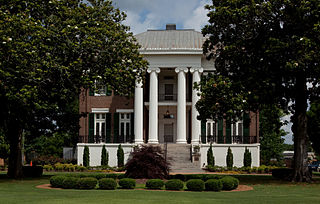
Rogers Hall, also known as Courtview, is a three-story antebellum house at 500 Court Street in Florence, Alabama. It was built from 1854 to 1855. It is one of the oldest historic landmarks on the University of North Alabama campus and one of the university's most distinctive structures. The building was recorded by the Historic American Buildings Survey from 1934–35. It was listed on the National Register of Historic Places on June 13, 1974.

The Nannie Helen Burroughs School, formerly known as National Training School for Women and Girls, was a private coeducational elementary school at 601 50th Street NE in Washington, D.C. The school was founded in 1909 by Nannie Helen Burroughs as The National Trade and Professional School for Women and Girls, Inc. and was the first school in the nation to provide vocational training for African-American females, who did not otherwise have many educational opportunities available to them. The 1928 Trades Hall building, the oldest building on the campus, was declared a National Historic Landmark in 1991. The property now houses the headquarters of the Progressive National Baptist Convention as well as the Monroe School, a private junior-senior high school that continues Burroughs' legacy.

The Hawthorne House, also known as the Col. J. R. Hawthorne House, is a historic plantation house in Pine Apple, Alabama, USA. The two-story wood-frame house was built in 1854 for Joseph Richard Hawthorne by Ezra Plumb. Joseph Hawthorne was born in 1805 in North Carolina, but the family had relocated to Wilkinson County, Georgia by 1810. Hawthorne moved to Conecuh County, Alabama in the 1830s and finally settled in Pine Apple in the 1850s. He owned several large plantations in Conecuh and Wilcox counties. He died in Pine Apple in 1889. The house was sold out of the family after his death, but was brought back into the family when acquired in 1935 by Gladys Hawthorne Whitaker and her brother, Dr. Julian Hawthorne, a New York physician. They restored the house and it remained in the family until Mrs. Whitaker's death in 1980. The house was recorded by the Historic American Buildings Survey in 1937. It was purchased after the death of Mrs. Whitaker by Dr. Edward Childs of Mobile. The house was added to the Alabama Register of Landmarks and Heritage on November 9, 1992 and to the National Register of Historic Places on March 7, 1985 with the name of Hawtorn House.

The Greensboro Historic District is a historic district in the city of Greensboro, Alabama. Greensboro was incorporated as a town in December 1823 as Greensborough. The community was known as Troy prior to that time. The historic district is centered on Main Street and runs from Hobson Street on the western side of the city to 1st Street on the eastern side. It features examples of Federal, Greek Revival, and regional vernacular architecture. One significant contributing property is Magnolia Hall. It was placed on the National Register of Historic Places on August 13, 1976.

The President's Mansion is a historic Greek Revival style mansion on the campus of the University of Alabama in Tuscaloosa, Alabama. It has served as the official residence of university presidents ever since its completion in 1841. The structure narrowly avoided destruction during the American Civil War, making it one of the oldest surviving buildings on campus today. The mansion was added to the National Register of Historic Places on January 14, 1972, due to its architectural and historical significance.

Sturdivant Hall, also known as the Watts-Parkman-Gillman Home, is a historic Greek Revival mansion and house museum in Selma, Alabama, United States. Completed in 1856, it was designed by Thomas Helm Lee for Colonel Edward T. Watts. It was added to the National Register of Historic Places on January 18, 1973, due to its architectural significance. Edward Vason Jones, known for his architectural work on the interiors at the White House during the 1960s and 70s, called it one of the finest Greek Revival antebellum mansions in the Southeast.
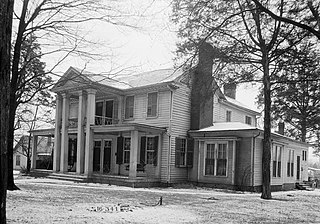
The Houston Memorial Library, previously the Governor George Smith Houston House, is a historic residence in Athens, Alabama. It was built in Federal style in 1835. The house was listed on the National Register of Historic Places in 1986.

The Richards DAR House is a historic house museum in Mobile, Alabama, United States. The Italianate style house was completed in 1860 for Charles and Caroline Richards. It is a contributing property to the De Tonti Square Historic District, which was listed on the National Register of Historic Places on February 7, 1972. The four Daughters of the American Revolution (DAR) chapters in Mobile jointly operate and maintain the house. It is noted by architectural historians as one of Mobile's best preserved and elaborate examples of mid-19th century domestic architecture.

The 'Wesley Plattenburg House is a historic house in Selma, Alabama. Featuring a unique combination of the Greek Revival and Italianate styles, it was completed in 1842 for Wesley Plattenburg. Plattenburg was born on April 13, 1803 in Anne Arundel County, Maryland. He had relocated to Selma and had assumed the occupation of tailor by 1829. He became a successful merchant and served on the city council of Selma for many years.
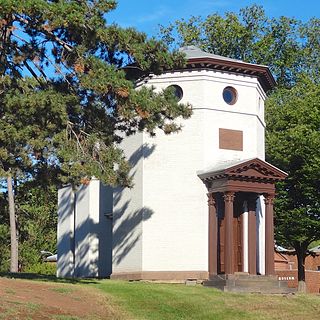
The Daniel S. Schanck Observatory is an historical astronomical observatory on the Queens Campus of Rutgers University in New Brunswick, New Jersey, United States. It is located on George Street near the corner with Hamilton Street, opposite the parking lot adjacent to Kirkpatrick Chapel, and to the northeast of Old Queens and Geology Hall.
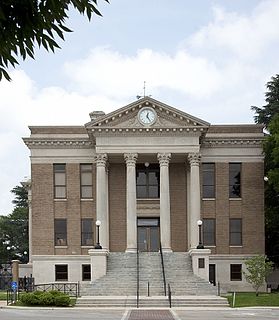
The Athens Courthouse Square Commercial Historic District is a historic district in Athens, Alabama. Athens was founded in 1818 when Robert Beaty and John D. Carroll began selling tracts of land. The following year, the town was chosen as the county seat of the newly formed Limestone County. Commercial development around the courthouse square was swift, aided by the strong cotton market. The town and courthouse suffered heavy damage during the Civil War in the Battle of Sulphur Creek Trestle. Athens' revival was slowed by major fires in 1882, 1894, and 1897, as well as the Panic of 1893. Redevelopment was spurred again in the 1910s and 1920s by a diversified economy with increased manufacturing, and in the 1930s by electricity provided by the Tennessee Valley Authority. Notable buildings in the district are the Limestone County Courthouse, built in 1919 in Neoclassical style with Palladian influences. The Old Post Office building was completed in 1933. The district was listed on the National Register of Historic Places in 1997 and the Alabama Register of Landmarks and Heritage in 2012.

The Robert Beaty Historic District is a historic district in Athens, Alabama. Robert Beaty was one of the original founders of Athens. An Irish immigrant who settled in Virginia, Beaty and his associates purchased 160 acres around a spring, and began subdividing the land for sale in 1818. A small village of log structures had formed by 1826, and began to be replaced by permanent homes over the next decade. Beaty's own house was completed in Federal style in 1826. William Richardson, whose son William, Jr., served in the U.S. House of Representatives, completed his home the following year. The district contains 86 contributing properties representing architectural styles including Federal, Greek Revival, Italianate, Eastlake, Victorian, and Spanish Colonial Revival. The district was listed on the National Register of Historic Places in 1984.
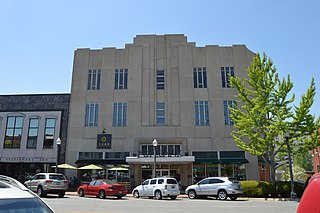
Rogers Department Store was a department store chain based in Florence, Alabama. Founded in 1894, the company grew to include locations across the Tennessee Valley. The original building, constructed in 1910, was listed on the Alabama Register of Landmarks and Heritage in 1994 and the National Register of Historic Places in 1998.

The William Winston House is a historic residence in Tuscumbia, Alabama. Construction was begun in 18?? by merchant Clark T. Barton, and finished in 1824 by planter William Winston. Winston's son, John A. Winston, was Governor of Alabama from 1854 until 1857; Winston's daughter married another Governor, Robert B. Lindsay. The house remained in the family until 1948, when it was sold to the city, which constructed a new campus for Deshler High School around the house.

Ravenna is a historic two-and-a-half-story mansion in Natchez, Mississippi, U.S.. It was built in 1835-1836 for William Harris, a merchant commissioner, planter and Natchez alderman. It was designed in the Greek Revival architectural style, based on plans by Asher Benjamin. By the 1850s, it was purchased by the Melcalfe family, whose descendants owned the house until they sold it to Dr. Mallan Morgan in the 1980s. It has been listed on the National Register of Historic Places since November 4, 1982.


























